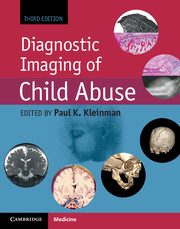Book contents
- Frontmatter
- Dedication
- Contents
- List of Contributors
- Editor’s note on the Foreword to the third edition
- Foreword to the third edition
- Foreword to the second edition
- Foreword to the first edition
- Preface
- Acknowledgments
- List of acronyms
- Introduction
- Section I Skeletal trauma
- Section II Abusive head and spinal trauma
- Chapter 16 Abusive head trauma: clinical, biomechanical, and imaging considerations
- Chapter 17 Abusive head trauma: scalp, subscalp, and cranium
- Chapter 18 Abusive head trauma: extra-axial hemorrhage and nonhemic collections
- Chapter 19 Abusive head trauma: parenchymal injury
- Chapter 20 Abusive head trauma: intracranial imaging strategies
- Chapter 21 Abusive craniocervical junction and spinal trauma
- Section III Visceral trauma and miscellaneous abuse and neglect
- Section IV Diagnostic imaging of abuse in societal context
- Section V Technical considerations and dosimetry
- Index
- References
Chapter 20 - Abusive head trauma: intracranial imaging strategies
from Section II - Abusive head and spinal trauma
Published online by Cambridge University Press: 05 September 2015
- Frontmatter
- Dedication
- Contents
- List of Contributors
- Editor’s note on the Foreword to the third edition
- Foreword to the third edition
- Foreword to the second edition
- Foreword to the first edition
- Preface
- Acknowledgments
- List of acronyms
- Introduction
- Section I Skeletal trauma
- Section II Abusive head and spinal trauma
- Chapter 16 Abusive head trauma: clinical, biomechanical, and imaging considerations
- Chapter 17 Abusive head trauma: scalp, subscalp, and cranium
- Chapter 18 Abusive head trauma: extra-axial hemorrhage and nonhemic collections
- Chapter 19 Abusive head trauma: parenchymal injury
- Chapter 20 Abusive head trauma: intracranial imaging strategies
- Chapter 21 Abusive craniocervical junction and spinal trauma
- Section III Visceral trauma and miscellaneous abuse and neglect
- Section IV Diagnostic imaging of abuse in societal context
- Section V Technical considerations and dosimetry
- Index
- References
Summary
Introduction
How and when to image the head in infants and children with suspected abusive head trauma (AHT) has become more complex with the increasing widespread availability of robust and elegant imaging technologies. These complex decisions are generally individualized based on available resources and expertise. The evidence base is modest with respect to the comparative diagnostic performance of the various neuroimaging modalities or magnetic resonance imaging (MRI) sequences in this specific context (1–5). Based on the available literature and the expertise of a panel of experts, the American College of Radiology (ACR) has put forth “Appropriateness Criteria” for imaging AHT and the organization periodically updates their recommendations in light of new data (6, 7). The goal of this chapter is to provide guidance to imaging departments that reflects the authors’ experience in light of current knowledge. Imaging strategies with respect to the skull, scalp, and subscalp have been covered in Chapter 17 – this discussion will focus on the approach to imaging the intracranial alterations described in Chapters 18 and 19. Craniocervical junction and spinal imaging strategies are addressed in Chapter 21.
Sonography
Sonography is a valuable imaging tool used to assess children with suspected AHT. The anterior and posterior fontanels and squamosal portions of the temporal bones (transmastoid) serve as natural acoustic windows for cranial sonography in infants up to six months of age. Cranial sonography is a low-cost, noninvasive modality that can be performed at the bedside without sedation, and is particularly useful in evaluating children with severe AHT in the intensive care unit who are too unstable for transport to the radiology department and prolonged imaging in the MRI suite. This modality allows for prompt assessment of hydrocephalus, some subdural hematomas (SDHs), parenchymal abnormalities, and mass effect; and can detect small white matter lacerations (contusional tears) – lesions that may go undetected on head computed tomography (CT) and are considered highly suggestive of inflicted injury (8). Color and spectral Doppler analysis provide useful information with regard to cerebral blood flow and readily detect occlusive thrombosis of the superior sagittal venous sinus.
- Type
- Chapter
- Information
- Diagnostic Imaging of Child Abuse , pp. 487 - 493Publisher: Cambridge University PressPrint publication year: 2015
References
- 2
- Cited by



